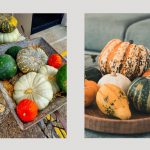This time of year, sprawling, prolific pumpkin vines can be the autumnal gift that keeps on giving.
Words Jennifer Stackhouse
By autumn, pumpkin vines are likely to have sprawled over every available space and are probably considering scaling the fence, while the yellow female flowers on each trailing arm will have swollen to form small pumpkins.
The vines don’t realise they’ve done enough and need to concentrate on growing bigger fruit — they just keep on sprawling and flowering until the weather turns cold.
Pumpkins can spread 3–7m from their starting point, especially if growing in rich soil with plenty of sunshine.
If your vine is sporting fruit, pinch out the growing tip to encourage the vine to stop spreading and concentrate its energy into growing bigger pumpkins while the weather is still warm.
If space is tight, pumpkins can be trained to grow vertically — for example, on a wire frame, fence or other support. The vine will hang on using its tendrils.
If any tying is needed, use very soft ties. Also, support the developing fruit by using a sling made from an old stocking — or repurpose a macrame-style holder as a hanging basket.
Keep pumpkin vines growing strongly with regular watering, especially if the weather is hot and dry.
They’ll keep growing until the first frost, which will kill off all the growth, leaving the pumpkins standing out among the dying stems.

Harvesting and storing
Pumpkins are ready to harvest in late autumn, usually four to five months after planting.
By this stage the fruit is large and heavy. Depending on the variety, pumpkins can weigh between 2kg and 9kg with small varieties coming in at just 80–200g.
Skin colour may change as the pumpkin ripens but, as many pumpkins are green when ripe, colour isn’t always the best way to gauge ripeness.
If the pumpkin looks like it’s ready to harvest, test it by rapping on its skin with your knuckles. A pumpkin that’s ready to harvest should sound drummy (hollow). If the pumpkin isn’t ready, leave it to keep maturing.
Fruits may be attacked by rodents, especially mice, which gnaw on the skin and can damage the fruit so it can’t be stored. To keep mice away, make a protective cage or enclosure around plants.
If the soil is wet in autumn when pumpkins are still on the vine, slip a flat stone or tile under the fruit to keep the skin from touching the wet ground and perhaps rotting.
To harvest the pumpkin, cut it from the vine but leave a piece of stem attached. This stops the fruit from rotting when stored — and pumpkins are well suited to storing.
To make sure they last through winter, allow the skin to “cure” or harden in the sun for a week or so. Undamaged pumpkins can be stored in a cool, airy spot for several months.
Check stored fruit regularly, monitoring for rot or damage (caused, for example, by rodents). Don’t store pumpkins with damaged skin — these should be used up quickly.
Celebrating Autumn
As pumpkins are naturally ready to harvest in late autumn, they have become associated with Halloween celebrations in the Northern Hemisphere.
Jack-o’-lanterns are hollowed-out pumpkins with their orange skins carved into scary faces lit from within by candles.

The pumpkins used for carving are large, soft-skinned varieties that don’t make good eating and are grown mainly for stock feed; Australian pumpkins tend to be thick-skinned and not suited to carving or hollowing out.
While we don’t celebrate Halloween in autumn in Australia, pumpkins — even uncarved — are highly ornamental for autumn parties such as harvest feasts.
Pumpkin label
Common name: Pumpkin, winter squash
Botanical name: Cucurbita maxima
Family: Cucurbitaceae
Aspect & soil: Sun; deep, moist, fertile soil
Best climate: All, but in cold areas grow in the warmest part of the year
Habit: Annual vine
Propagation: Seed, seedling
Difficulty: Easy
Image credit: Kerry Boyne, Shutterstock










